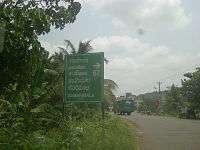Sabarimala
| Sabarimala | |
|---|---|
| ശബരിമല | |
|
Sabarimala Shreekovil | |
 Sabarimala Location in Kerala | |
| Name | |
| Sanskrit transliteration | śabarīmalā |
| Kannada | ಶಬರಿಮಲೆ |
| Geography | |
| Coordinates | 9°26′15″N 77°04′50″E / 9.4375°N 77.0805°ECoordinates: 9°26′15″N 77°04′50″E / 9.4375°N 77.0805°E |
| Country | India |
| State/province | Kerala |
| District | Pathanamthitta |
| Locale | Perunad |
| Elevation | 1,260 m (4,134 ft) |
| Culture | |
| Primary deity | Dharmasasta as Ayyappa |
| Important festivals | Makaravilakku |
| Architecture | |
| Architectural styles | Kerala Temple architecture |
| Number of temples | 4 |
| History and governance | |
| Date built | Before 12th century AD |
| Creator | Unknown |
| Website |
www |
Sabarimala is a Hindu pilgrimage centre located at the Periyar Tiger Reserve in the Western Ghat mountain ranges of Pathanamthitta District, Perunad grama panchayat in Kerala. It is one of the largest annual pilgrimages in the world with an estimated over 100 million devotees visiting every year.[1][2] Ayyappan's temple is situated amidst 18 hills. The temple is situated on a hilltop at an altitude of 1260 m (4,133 ft) above mean sea level, and is surrounded by mountains and dense forests. The dense forest, (Periyar Tiger Reserve), around the temple is known as Poongavanam. Temples exist in each of the hills surrounding Sabarimala. While functional and intact temples exist at many places in the surrounding areas like Nilakkal, Kalaketty, and Karimala remnants of old temples survive to this day on remaining hills.
The shrine at Sabarimala is an ancient temple of Ayyappan also known as sasta and Dharmasasta. In the 12th century, Manikandan, a prince of Pandalam dynasty, meditated at Sabarimala temple and became one with the divine. Manikandan was an avatar of Ayyappan.
Sabarimala is linked to pilgrimage predominantly undertaken by Hindus. Sabarimala pilgrims can be identified easily, as they wear black or blue dress. They do not shave until the completion of the pilgrimage, and smear Vibhuti or sandal paste on their forehead.
In 1991, the Kerala High Court restricted entry of women above the age of 10 and below the age of 50 from offering worship at Sabarimala Shrine during any period of the year. Presently, the Supreme Court of India has taken a petition to review the judgment of High Court and allow entry of women. The Supreme Court hearings are in progress and no decision has yet been made.[3]
The temple is open for worship only during the days of Mandalapooja (approximately 15 November to 26 December), Makaravilakku or "Makara Sankranti" (14 January) and Maha Vishuva Sankranti (14 April), and the first five days of each Malayalam month.
The pilgrimage
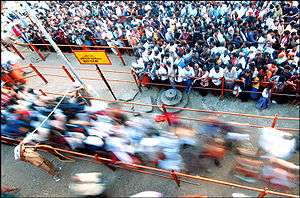
The devotees are expected to follow a Vratham (41-day austerity period) prior to the pilgrimage.[4] This begins with wearing of a special Mala (a chain made of Rudraksha or Tulasi beads is commonly used, though still other types of chains are available.). During the 41 days of Vratham, the devotee who has taken the vow, is required to strictly follow the rules that include follow only a lacto-vegetarianism diet, follow celibacy, follow teetotalism, not use any profanity, allow the hair and nails to grow without cutting. They must try their maximum to help others, and see everything around them as lord Ayyappa. They are expected to bath twice in a day and visit the local temples regularly and only wear plain black or blue colored traditional clothing. Saffron colored dresses are worn by Sannyasi who have renunciated material life. But, many devotees still continue to wear saffron colored clothes which becomes a part of Vedic culture which connects the whole Hindus worldwide.
Hundreds of devotees still follow the traditional mountainous forest path (approximately 61 km) from Erumely,12.8 km from Vandiperiyar and 8 km from Chalakayam, believed to be taken by Ayyappa himself. The Erumely route starts from Erumely to Aludha river, then crosses the Aludha mountain to reach Karivilam thodu. Now comes the sacred Karimala crossing, from there to Cheriyanavattom, Valliyanavattom and finally Pamba River. Then they have to climb Neelimala and enter into the Ganesha-Bettam, Shreerama-Betta Padam. Then comes the Aranmula kottaram, which is one of the stops of holy journey 'Thiruvabharana Ghoshayatra' (the grand procession of the divine jewelery).
These days people use vehicles to reach the Pamba River by an alternate route. From Pamba, all the pilgrims begin trekking the steep mountain path of Neeli Mala till Sabari Mala. This route is now highly developed, with emergency shops and medical aid by the sides, and supporting aid is provided to the pilgrims while climbing the steep slope, which used to be a mere trail through dense jungle. The elderly pilgrims are lifted by men on bamboo chairs till the top, on being paid.
Women pilgrims
Women in large numbers did not visit the temple, due to the hardship in reaching the temple.[5] Women pilgrims above the age of 50 would visit the temple to conduct the first rice-feeding ceremony of their children (Chottoonu) in the temple premises.[5] On May 13, 1940, even the Maharani of Tranvancore had visited the temple.[5][6]
In 1991, Justice K Paripoornan and Justice K Balanarayana Marar of the Kerala High Court in their ruling against the Travancore Devaswom Board, banned entry of women between ages above the age of 10 and below the age of 50 from offering worship at Sabarimala Shrine during any period of the year stating that such restriction was in accordance with the usage prevalent from time immemorial.[5] In addition, the Justices of the High court directed the Government of Kerala, to use police force to ensure the order to ban entry of women to the temple was implemented and complied with.[5]
Origins of Sabarimala temple
The worship of Sastha forms part of the very ancient history of south India.[7] At Sabarimala, the deity is worshiped as Ayyappan and as Dharmasasta. The shrine of Sabarimala is an ancient temple. The prince of Pandalam dynasty, an avatar of Ayyappan, meditated at Sabarimala temple and became one with the divine. The place where the prince meditated is the Manimandapam.
There are many Sastha temples in South India and across the globe.[8] As per the temple history, the Sastha temple at Sabarimala is one of the five Sastha temples founded by Lord Parasurama. The other Sastha temples in this group of five includes the Ayyappan Temples:[9] at Kulathupuzha, where the Sastha appears as a Balaka or child; at Aryankavu where the Lord appears as a Brahmachari or young man; at Achankovil Shastha Temple, where the lord leads the Grihastha Ashrama life here and depicted along with his two wives - Purna and Pushkala;[10] at Sabarimala, where the lord is depicted in the Vanaprastha or form of renunciation; at Poonambala Medu the Lord appears as a yogi and where the "makaravilaku' is lit.[11]
. .
After the installation of the temple, it was mostly unreachable for about three centuries. In the 12th century, a Tamil king called Rajasekhara Pandiyan (a prince of Pandalam Dynasty), called Manikandan, rediscovered the original path to reach Sabarimala. He had many followers with him, including the descendants of the Vavar (a Muslim warrior whom Manikandan defeated) family. This Prince is considered an Avatar of Ayyappa, and is believed to have led a pack of Tigers to his Palace with Vavar and then later disappeared to the Sabarimala temple. The temple was then renovated.
In 1821 AD, the kingdom of Pandalam was added to Travancore. 48 major temples including the Sabarimala temple were also added to Travancore. The idol was erected in 1910.
The Temple Layout
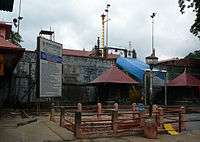
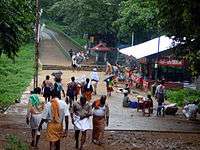
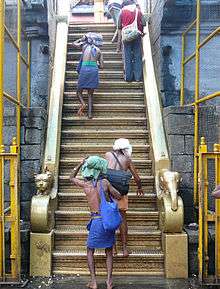

The Sannidhanam (main temple) is built on a plateau about 40 feet high.[12][13][14]
The temple was rebuilt after a fire in 1950, In 1950, the temple was suspected to be set on fire by radical Christian extremists which destroyed the entire temple and had to be reconstructed.[15][16]and the earlier stone image of the deity was replaced by a panchaloha idol, about 1 and half feet, made from an alloy from five metals.
The temple consists of a sanctum sanctorum with a copper-plated roof and four golden finials at the top, two mandapams, the belikalpura which houses the altar. In 1969, the flag staff (dhwajam) was installed.
The shrine of Kannimoola ganapathi prathishta is south-west to The Sreekovil of the Sannidhanam. Devotees offer part of the broken coconut (Neythenga) to Sri Ganapathi in the fireplace (Azhi). Ganapathi homam is the main offering.[14]
The shrine of the Lord of snakes, Nagarajav is placed adjacent to the sreekovil. Pilgrims after the Darsan of Lord Ayyappa and Kannimoola Ganapathi, make their darsan and give offerings to Nagarajav.
The Pathinettu thripadikal or the 18 sacred steps is the main stairway to the temple. As per the custom followed, no pilgrim without "Irumudikkettu" can ascend the 18 sacred steps. In 1985, the 18 steps were covered by panchaloka and later covered with gold. The stairway in northern gate is open for those who do not carry an "Irumudikkettu".
The temples of Lord Ayyappan's trusted lieutenants Karuppu Sami and Kadutha Swami are positioned as his guards at the foot of the holy 18 sacred steps.
The temple of Malikappurath Amma, whose importance is almost in par with Lord Ayyappa,[13] is located few yards from Sannidhanam. It is believed that the Lord Ayyapan had specific instructions that he wanted Malikappurath Amma, on his left side. Prior to the fire disaster, there was only a Peeda Prathishta (holy seat) at Malikappuram. The idol of Malikappurath Amma was installed by Brahmasree Kandararu Maheswararu Thanthri. The Devi at Malikappuram holds a Sankh, Chakram and Varada Abhya Mudra. Now the idol is covered with a gold Golaka. The temple also was reconstructed in the last decade and now the conical roof and sopanam is covered with gold.[17]
Manimandapam, located nearby is where Ayyappa meditated, before he became one with the divine.[17]
The Sabarimala temple complex include Pampa Ganapathi temple, Nilakal Mahadeva temple and Palliyara Bhagavathi temple. The Nilakal Mahadeva temple and Palliyara Bhagavathi temple is as old as the Sastha temple and the deities are worshiped as the parents of Lord Ayyappa. Ganapathi temple at Pampa has Pampa Maha Ganapathi and Athi Ganapathi (lit. old ganapathy), sreekovil where the idol from the first Ganapathy temple is worshiped. Sabari Peedam blessed with the footprints of Sri Rama has a temple of Sri Rama and Hanuman also.[13]
Administration
Administration and legal duties is managed by Travancore Devasvom Board, an affiliate authority of Government of Kerala. Thazhamon Madom is the traditional priest family who has powers over the religious matters to be decided in Sabarimala Temple. Tantri is the highest priest and is the head of the temple. It's the duty of the family to decide on religious matters relating to Sabarimala shrine. Tantris are to be present in all ceremonial Poojas and functions to be held at temple premises and functions associated with temple. The installation of idols of the temple was also done by Tantri of this family.
Currently Brahmasri Kantararu Maheshwararu Tantri is the head priest of Sabarimala. The other famous family members include Kandararu Rajeevararu, Kandararu Mohanararu and Kandararu Mahesh Mohaner.
Prasadam
The prasadam at Sabarimala temple is Aravana payasam and Appam. These are prepared by using rice, ghee, sugar, jaggery etc. The rice needed to prepare the prasadam at Sabarimala temple is supplied by Chettikulangara Devi Temple, the second largest temple under the Travancore Devaswom Board situated at Mavelikkara. The Chief Commissioner, Travancore Devaswom Board said that the board has appointed Central Food Technological Research Institute, Mysore as a consultant for providing technical guidance to ensure the quality of Aravana, Appam and other prasadam preparations at Sabarimala temple.[18]
Harivarasanam
Harivarasanam is recited before closing the temple door every night. The Harivarasanam prayer, which is sung at Sabarimala is a Urakkupattu. It is composed by Sri Kambangudi Kulathur Srinivasa Iyer in Sanskrit. It is said that Srinivasa Iyer used to recite the composition after the Athazha Puja, standing in front of the shrine of Ayyappa in the main temple. With the efforts of Swami Vimochanananda, it came to be accepted as the lullaby by the Tantri and Melshanthi. The composition has 352 letters, 108 words in 32 lines in 8 stanzas.[19]
Though there have been many versions of this song sung by many renowned vocalists, the temple plays the rendition by K. J. Yesudas, composed by the renowned music director G. Devarajan, which is in the Madhyamavathi raga of Indian Carnatic music.[20]
Neyyabhishekam
This significant ritual involves pouring sacred ghee brought by pilgrims in their Pallikettu or Irumudi (A two compartment bag made of handwoven cotton cloth used to carry the offerings for Sabarimala Temple carried on their heads) on the idol of Lord Ayyappa. It symbolically means the merging of Jeevatma with the Paramatma. While a red-colored irumudi is used by a pilgrim on his first journey as a Kanni Ayyappan to Sabarimala, others use navy blue till third year and thereafter saffron colored irumudi.
Makara Vilakku
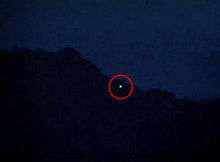
Lord Rama and his brother Lakshmana met Sabari, a tribal devotee, at Sabarimala. Sabari offered the Lord fruits after tasting them. But the Lord accepted them gladly and whole-heartedly. The Lord then saw a divine person doing tapasya. He asked Sabari who it was. Sabari said it was Shasta. Rama walked towards him. Shasta stood up and welcomed the Prince of Ayodhya. The anniversary of this incident is celebrated on Makara Vilakku day. It is believed that on Makara Vilakku day, Lord Dharmashasta stops his tapasya to bless his devotees. The day is also called Makara Shankranthi
Aham Brahmasmi and Tattvamasi
The important message written at the temple facade is one of the four Mahāvākyas of Tat Tvam Asi which in sanskrit means "That Thou Art". Due to this pilgrims call each other Swami acknowledging their divinity.
It means, in short, you are part of the Paramatma which is the quintessence of Advaita philosophy.
Illumination and Power
In this remote hill shrine the Kerala State Electricity Board (KSEB) is shouldering the task of providing sufficient illumination in base camps, trekking paths and the Sannidhanam, the shrine spot. KSEB installs and maintains around 15000 electric lamps of various types here. Power is brought here through Kochu Pampa and Thriveni substations. Through uninterrupted supply and well maintained lights KSEB has been able to maintain good reputation in the recent years.[21][22]
The history behind the worshiping methods
The customs of the pilgrims to Sabarimala are based on five worshipping methods; those of Shaivites, Shaktists and Vaishnavites. At first, there were three sections of devotees – the devotees of Shakti who used meat to worship their deity, the devotees of Vishnu who followed strict penance and continence, and the devotees of Shiva who partly followed these two methods. Another name of Ayyappa is Sastha. All these can be seen merged into the beliefs of pilgrims to Sabarimala. The chain the pilgrims wear comes from the Rudraksha chain of the Shaivites. The strict fasting, penance and continence is taken out of the beliefs of the Vaishnavites. The offering of tobacco to Kaduthaswamy can be considered to be taken from the Shaktists.
Environmental efforts
The waste disposed by the visitors to Sabarimala is threatening the wildlife of the region[23][24][25] and the evergreen forests.[26] Efforts are on to make Sabarimala free from pollution and waste. High Court of Kerala has directed that 'Irumudikkettu' should not contain plastic materials.[27] Projects like "Punyam Poonkavanam" has been initiated under the aegis of governmental departments.[28] Hindu organisations such as Art of Living and Mata Amritanandamayi Math has been regularly contributing to keep Sabarimala and its precincts clean.[29][30][31][32] While cleaning Pamba river Sabarimala Sanndidhaanam clean is their primary objective,[33] the broader vision is to spread the message of greenness and cleanliness beyond Sabarimala.
Some of the salient aspects of "Punyam Poonkavanam" project includes:[34]
- Not using soap and oil while bathing in the holy Pamba River. No throwing any material, including clothes in the holy river.
- To prepare irumudikkettu without using any plastic and using only bio-degradable materials.
- To devote at least one hour in cleanliness activities at Sabarimala Sannidhaanam, River Pamba and surroundings as part of the pilgrimage.
Transport

Airport
Nearest airports are Thiruvananthapuram International Airport (170 kilometres (110 mi)) and Cochin International Airport (160 kilometres (99 mi)).
Kerala cabinet gave in-principle approval for setting up a greenfield airport to be named as Sabarigiri International Airport. Among 5 sites of which 4 in Pathanamthitta, the first preference goes to Cheruvally estate in Kottayam District given the strong soil, topography and other factors per the US consulting firm. The Sabarigiri International Airport will give wings for the growth of VIP and foreigners visits and make may it the most revenue generating temple in India. It will change the life and property value of many people in the nearby areas. A new airport has been planned to be set up near Cheruvally which is about 50 km from Sabarimala.[35]
Helicopter
Sabarimala Heliport is situated in Perunad about (40 kilometres (25 mi)) from pampa, which is also known as Sabarimala helipad. And Chipsan Aviation Pvt Ltd, being the sole chartered operator.
Rail
Chengannur (82 kilometres (51 mi)), Sasthamkotta (100 kilometres (62 mi)), Kottayam (120 kilometres (75 mi)) and Kollam Junction (129 kilometres (80 mi)) are some of the closest accessible railway stations from Sabarimala.
Road
The main trunk road of about 70 kilometres (43 mi) to Sabarimala is Pathanamthitta-Pamba, which passes through, Mannarakulanji, Vadasserikara, Perunad, Lahai & Nilakkal. Kerala State Road Transport Corporation operates regular daily bus services from Pathanamthitta, Thiruvananthapuram, Ernakulam and Kumili. Direct Bus services to Pathanamthitta, Erumeli and Pamba are operated from Chengannur railway station.
Other nearby temples
- Valiyakoikkal Temple, Pandalam
- Nilakkal Sree Mahadeva Temple, Nilakkal, Pathanamthitta
- Sreevallabha Temple, Thiruvalla
- Hanuman Temple, Kaviyoor
- Nannoor Devi Temple, Vallamkulam
- Gurunathanmukadi Sri Ayyappaguru, Pandalam
- Aranmula Parthasarathy Temple
- Rektha Kanda Swamy Temple, Omallur, Pathanamthitta
- Orippurathu Bhagavathy Temple, Thattayil, Pathanamthitta
- Sreenarayanapuram Temple, Adoor
- Kottarakkara Sree Mahaganapathi Kshethram, Kottarakkara
- Chakkulathukavu Temple, Alappuzha
- Chengannur Mahadeva Temple, Chengannur
- Ettumanoor Mahadevar Temple, Ettumanoor, Kottayam
- Vaikom Temple, Vaikkom, Kottayam
- Chettikulangara Devi Temple, Mavelikkara
- Padanilam Parabrahma Temple, Padanilam, Mavelikkara
- Oachira Temple, Oachira, Kollam
- Mannarasala Temple, Harippad
- Puttingal Temple, Paravur
- Sasthamcotta Sree Dharma Sastha Temple
- Kunnekadu Sree DDharmasastha Temple.East Othera.Thiruvalla Pathanamthitta
See also
References
- ↑ "Why millions throng Sabarimala shrine". DailyBhaskar. 2011-01-15. Retrieved 2016-12-02.
- ↑ "Indo-Americans shocked at Sabarimala tragedy". Sify. Retrieved 2016-12-02.
- ↑ "Sabarimala temple case: Supreme Court to resume hearing on April 22 | Latest News & Updates at Daily News & Analysis". dna. 2016-04-18. Retrieved 2016-12-02.
- ↑ http://www.haindavakeralam.com/HKPage.aspx?PageID=12948&SKIN=D
- 1 2 3 4 5 Kerala High Court (5 April 1991) Bench: K Paripoornan, K B Marar; Source: (accessed Sunday May 1, 2016)
- ↑ "Travancore Devaswom Board " History of Temple, Sri Chithirathirunal Maharaja along with the Maharani and Diwan of Travancore made pilgrimage to the temple on May 13th, 1940.; Source: (accessed Saturday June 25, 2016)
- ↑ Asian Mythologies|Yves Bonnefoy|University of Chicago Press, 15 May 1993
- ↑ "Shrines for Sastha, in eight forms". The Hindu. Retrieved 2016-12-02.
- ↑ "Ayyappa Samaaj of San Francisco Bay Area". www.ayyappasamaaj.org. Retrieved 2016-12-02.
- ↑ "Achankovil Sri Dharmasastha temple | Travancore Devaswom Board". www.sabarimalaaccomodation.com. Retrieved 2016-12-02.
- ↑ "The Six Sastha Temples and the Shat Chakras". shanmatha.blogspot.hk. Retrieved 2016-12-02.
- ↑ "Sannidhanam sabarimala meaning | Brief on sabarimala sannidhanam". lordayyappa.com. Retrieved 2016-12-02.
- 1 2 3 "Sanctity of the temple | Travancore Devaswom Board". www.sabarimalaaccomodation.com. Retrieved 2016-12-02.
- 1 2 "Sabarimala-The pilgrimage is a symbol of love, equality, and devotion". www.sabarimala.org. Retrieved 2016-12-02.
- ↑ "Sabarimala Temple Arson Case Inquiry Report". https://www.scribd.com. External link in
|publisher=(help) - ↑ SABARIMALA TEMPLE KERALA. "SABARIMALA TEMPLE KERALA". Kerala: God's own Country. Retrieved 30 January 2017.
- 1 2 "Malikappurathamma Malikappuram Temple Sabarimala". www.vaikhari.org. Retrieved 2016-12-02.
- ↑ "CFTRI to monitor quality of Sabarimala prasadom". 6 August 2012.
- ↑ Harivarasanam History and meaning of harivarasanam.
- ↑ "Download Harivarasanam Songs & Lyrics, KJ Yesudas Harivarasanam Song Lyrics". www.ayyappatemple.in. Retrieved 2016-12-02.
- ↑ Official Police Report on Temple arson in 1950-http://www.firstministry.kerala.gov.in/pdf/bills/Reports/tmple_arsn.pdf
- ↑ Reporter, Staff. "Sabarimala review meeting held". The Hindu. Retrieved 2016-12-02.
- ↑ "ശബരിമലയില് ചത്ത മ്ലാവിന്റെ വയറ്റില് കിലോക്കണക്കിന് പ്ലാസ്റ്റിക്ക്". mathrubhuminews.in. Retrieved 2016-12-02. zero width joiner character in
|title=at position 11 (help) - ↑ "Going green? Kerala's Sabarimala temple rules against the use of plastics - Firstpost". Firstpost. 2016-01-15. Retrieved 2016-12-02.
- ↑ "Kerala High Court seeks probe into deer death". http://www.deccanchronicle.com/. 2016-01-07. Retrieved 2016-12-02. External link in
|newspaper=(help) - ↑ "Sabarimala and Periyar eternal yet threatened". Times Of India Blogs. 2014-06-22. Retrieved 2016-12-02.
- ↑ "'Irumudikkettu' should not contain plastic materials: HC". Mathrubhumi. Retrieved 2016-12-02.
- ↑ Vijayan, P. "'Punyam Poonkavanam' to cleanse Sabarimala". Mathrubhumi. Retrieved 2016-12-02.
- ↑ "sabarimala | Amala Bharatam അമലഭാരതം". e.amritapuri.org. Retrieved 2016-12-02.
- ↑ "Sabarimala clean-up: 35,000 bags of garbage collected". NDTV.com. Retrieved 2016-12-02.
- ↑ Kuttoor, Radhakrishnan. "200 foreigners take part in cleaning drive at Sabarimala". The Hindu. Retrieved 2016-12-02.
- ↑ "Clean-up drive at holy Pamba River in Sabarimala: 27 tons of litter removed so far". Retrieved 2016-12-02.
- ↑ Correspondent, Special. "Pampa to be included in Punyam Poonkavanam". The Hindu. Retrieved 2016-12-02.
- ↑ "Welcome to Official Site of Punyam Poonkavanam". www.punyampoonkavanam.org. Retrieved 2016-12-02.
- ↑ Sabarimala Airport
External links
| Wikimedia Commons has media related to Sabarimala. |
| Wikivoyage has a travel guide for Sabarimala. |
- Official Website Of Sabarimala
- Sabarimala Temple Opening Dates
- Sabarimala Darshan Online Booking Virtual Queue
- Sabarimala news and update (Non-official portal)
- Makara Jyothi in keralas ayappa swamy temple is man-made - Hindu
- Makara Jyothi in keralas ayappa swamy temple is man-made - temple Board president
- Website of Punyam Poonkavanam Project

